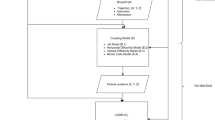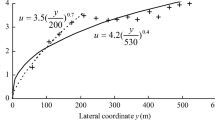Summary
The advection and dispersion of a patch of pollutant is modelled by following a patch of water-parcels or particles as it is advected by the mean circulation and spread by diffusion. The water circulation used in the model is the depth integrated climatological mean calculated by Backhaus [1985] for each of the four seasons. A Monte Carlo technique is used to simulate the dispersion caused by eddy diffusivity and variations in the flow field at time scales less than three months.
A group of particles is introduced at each release point and tracked for one year. At each time step a pseudo-random velocity is added to the advective velocity for each particle to simulate the effects of dispersion. The probability distribution for the pseudorandom velocity is uniform over the square.
whereA' is the horizontal diffusion coefficient and τ the time step (Mairer-Reimer and Sündermann [1982]).
To compare the results directly with those presented by Hainbucher, Pohlmann and Backhaus [1987] a group of particles is released at intervals throughout the year and their positions plotted at fixed time intervals after their release. The results produced by this simple method are broadly in agreement with the much more sophisticated and lengthly calculations presented by Hainbucher et al. [1987].
Zusammenfassung
Die Advektion und Dispersion eines Schadstoffflecks wird modelliert mit einer Gruppe von Wasserparzellen oder-teilchen, die durch die mittlere Zirkulation und durch Diffusion transportiert werden. Die im Modell verwendeten Zirkulationsfelder entsprechen den von Backhaus [1985] für jede der vier Jahreszeiten berechneten tiefenintegrierten klimatologischen Mittelwerten. Ein Monte-Carlo-Verfahren wird angewendet, um die Dispersion durch Vermischung und durch Veränderungen im Strömungsfeld bei Zeitskalen von weniger als drei Monaten zu simulieren.
An jedem Einbringungsort wird eine Gruppe von Teilchen losgelassen und ein Jahr lang verfolgt. Zur Simulierung der Dispersion wird bei jedem Zeitschritt der Advektionsgeschwindigkeit für jedes Teilchen eine Pseudo-Zufallsgeschwindigkeit überlagert. Für die Pseudo-Zufallsgeschwindigkeit gilt eine gleichmäßige Wahrscheinlichkeitsverteilung über dem Quadrat
wobeiA' den horizontalen Diffusionskoeffizienten und τ den Zeitschritt darstellt (Maier-Reimer und Sündermann [1982]).
Um einen direkten Vergleich der Ergebnisse mit den Werten von Hainbucher, Pohlmann und Backhaus [1987] zu ermöglichen, wird eine Gruppe von Teilchen in Zeitabständen während des ganzenJahres freigelassen und ihre jeweilige Position für bestimmte Zeitintervalle nach der Freisetzung ausgewertet. Die mit dieser einfachen Methode gewonnenen Ergebnisse stimmen weitgehend mit den viel komplexeren und aufwendigeren Berechnungen von Hainbucher et al. [1987] überein.
Résumé
L'advection et la dispersion d'une nappe de polluant sont modélisées en suivant une nappe de particules d'eau au fur et à mesure de son advection par la circulation moyenne et de sa propagation par difussion. La circulation de l'eau utilisée dans le modèle est la moyenne climatologique à intégration de profondeur calculée par Backhaus [1985] pour chacune des quatre saisons. Une technique de Monte Carlo est utilisée pour simuler la dispersion causée par la diffusivité tourbillonnaire et les variations dans le champ d'écoulement à des échelles de temps de moins de trois mois.
Un groupe de particules est introduit à chaque point de libération et suivi pendant un an. A chaque étape de temps, une vitesse pseudo-aléatoire est ajoutée à la vitesse d'advection pour chaque particule afin de simuler les effets de la dispersion. La répartition des probabilités pour la vitesse pseudo-aléatoire est uniforme sur le carré
oùA' est le coefficient de diffusion horizontale et τ l'étape de temps (Maier-Reimer et Sündermann [1982]).
Pour comparer directement les résultats à ceux présentés par Hainbucher, Pohlmann et Backhaus [1987], un groupe de particules est libéré à intervalles durant toute l'année et leurs positions sont relevées à des intervalles de temps fixes. Les résultats obtenus au moyen de cette méthode simple s'accordent en gros avec les calculs beaucoup plus sophistiqués et longs présentés par Hainbucher et autres [1987].
Similar content being viewed by others
References
Backhaus, J. O., 1985: A three-dimensional model for the simulation of shelf sea dynamics. Dt. hydrgr. Z.38, 165–187.
Hainbucher, D., T. Pohlmann, and J. O. Backhaus, 1987: Transport of conservative passive tracers in the North Sea: First results of a circulation and transport model. Continent. Shelf Res.7, 1161–1179.
Maier-Reimer, E. and J. Sündermann, 1982: On tracer methods in computational hydrodynamics. pp. 198–217. In: Engineering applications of computational hydraulics Vol. 1. M. B. Abbott and J. A. Cunge, Eds., Boston, London and Melbourne: Pitman Advanced Publishing Program.
Prandle, D., 1984: A modelling study of the mixing of Cs 137 in the seas of the European continental shelf. Philosophical Transactions of the Royal Society of London, A310, 407–436.
Author information
Authors and Affiliations
Rights and permissions
About this article
Cite this article
Durance, J.A. A model of pollutant dispersal in the North Sea. Deutsche Hydrographische Zeitschrift 42, 271–278 (1989). https://doi.org/10.1007/BF02226298
Received:
Accepted:
Published:
Issue Date:
DOI: https://doi.org/10.1007/BF02226298




